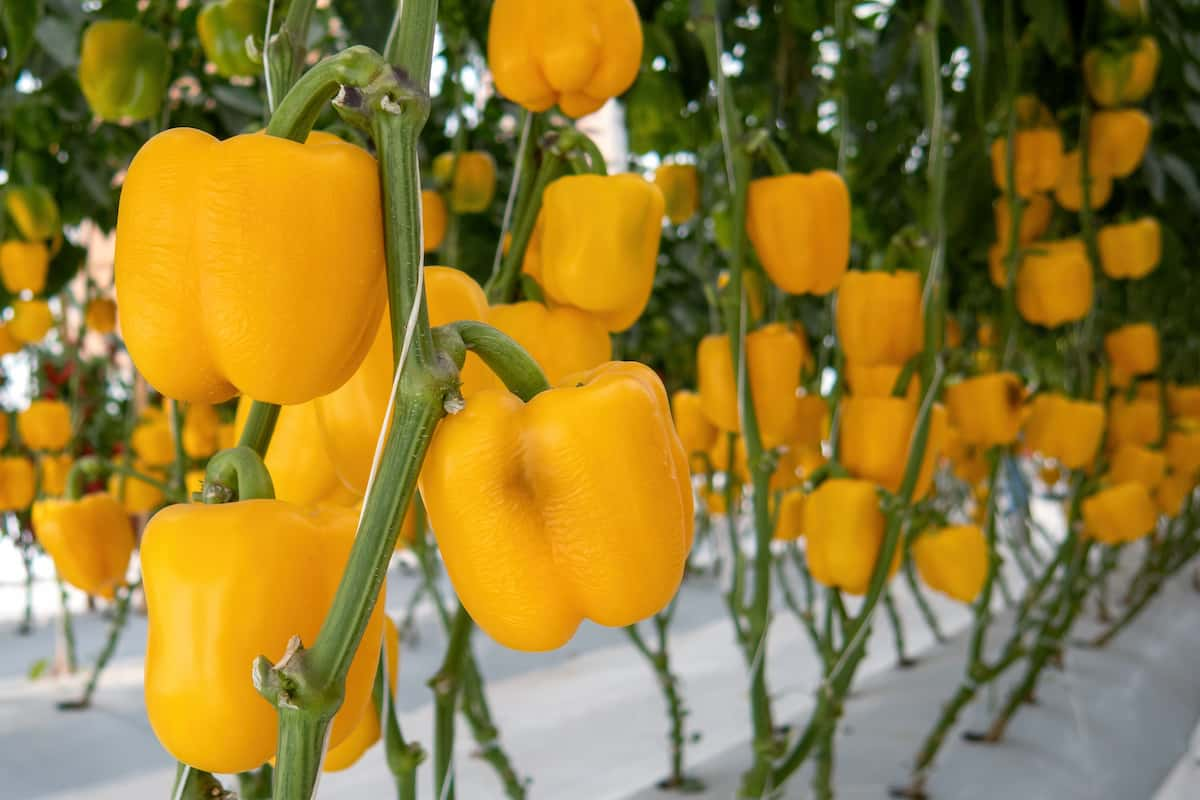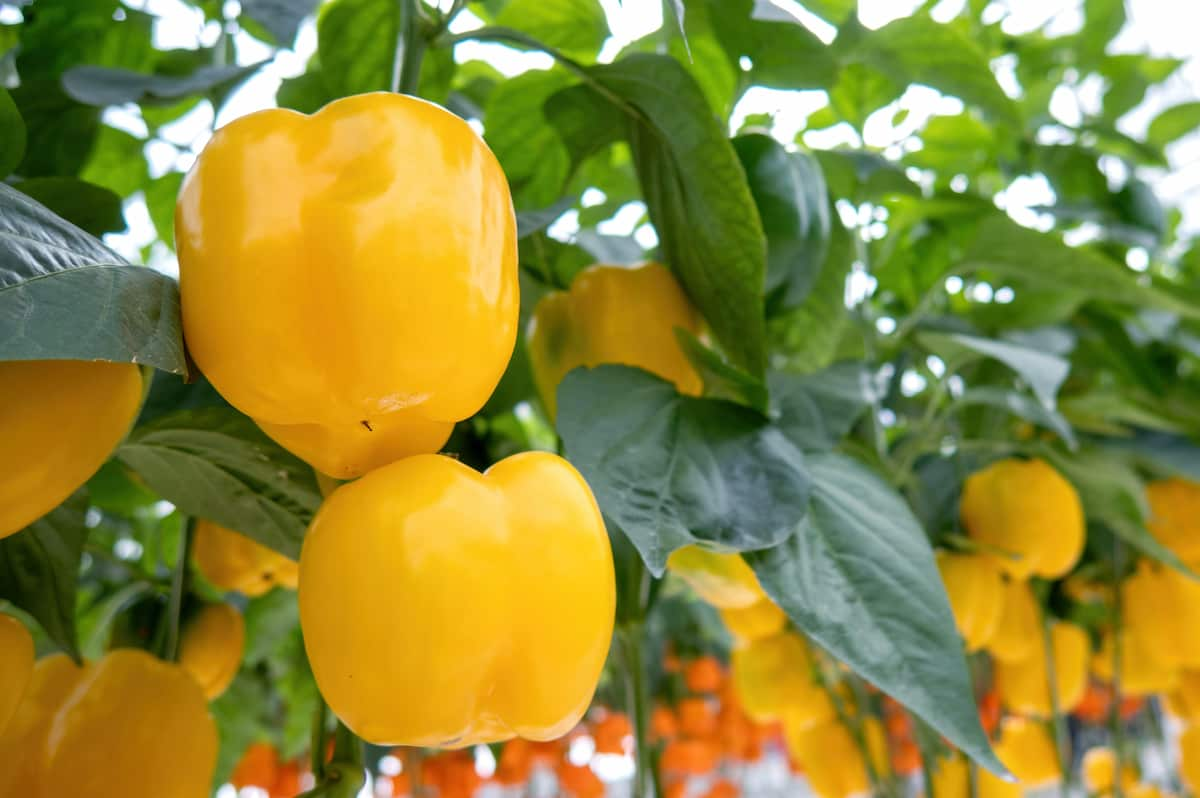Yellow Bell Peppers are a highly advantageous vegetable, delivering abundant yields and exceptional health benefits. These sturdy vegetables can endure both cold and warm climates and remain productive. They boast an extended shelf life, lasting for months without spoilage. Moreover, Yellow Bell Peppers are an excellent source of vital nutrients, including vitamins, minerals, fiber, and antioxidants.

Growing Yellow Bell Peppers is a cost-effective endeavor, requiring minimal resources and effort. These attributes make them an ideal crop for farmers looking to maximize their production potential while delivering nutritional benefits to consumers.
Yellow Capsicum/Bell Pepper Farming in Greenhouse/Polyhouse
Selection of the Site and Basic Soil Requirements for Yellow Bell Pepper Under Green House
Selecting the right site for protected cultivation is crucial and requires careful consideration. Areas with high rainfall and humidity can increase the risk of foliar diseases, while high wind velocity can damage the structure and increase maintenance costs. To avoid damage to the structure, avoid areas with heavy rain and gusty winds. Capsicum thrives in well-drained sandy loam soils with good percolation and a pH of 6 to 7 and EC < 1 mm hos/cm. Choosing the right location and soil conditions is essential for successful capsicum cultivation in protected environments.
Land Preparation for Yellow Bell Pepper Under Green House
For successful capsicum cultivation, the land should be plowed, and the soil should be finely tilled. Adding well-decomposed organic manure at 20-25 kg per sq mtr is recommended for optimal growth. One application is enough for three successive capsicum crops. Raised beds should be formed, 90-100 cm wide and 15-22 cm high, with 45-50 cm walking space between beds. Following these guidelines ensures that capsicum crops thrive in a well-prepared environment.
Green House/Polyhouse Structures Required for Yellow Bell Pepper
Net Houses or Shade Nets
These are cost-effective methods of vegetable cultivation(Yellow Bell Pepper). Granite stone pillars 12 feet in height and 8 x 4 inches in thickness are commonly used for construction, and they are placed 2 feet deep in the soil with concrete cement grouting. To avoid net tearing, the sharp edges of the pillars are covered with smooth materials like rubber tubes. A GI wire grid supports a 50% HDPE white shade net, with an additional retractable green or black 35% shade net used during hot summer mid-days
Poly House
It provides superior protection against rainwater compared to a net house, resulting in better control of leaf diseases and higher yields of around 15-20%. Typically constructed using GI pipes, and wooden or stone pillars, the roof of the poly house is covered with transparent UV-stabilized polyethylene film of 200-micron thickness. Retractable or movable shade nets are installed at 11 feet height, and the sides are covered with 200 microns thick polyethylene film up to 3 feet from the ground and 40 microns of white insect-proof netting for the remaining height.
Cultural and Nursery Practices
Selection of Cultivars
Capsicum hybrids are commonly grown in greenhouses because they provide continuous and regular flower and fruit settings over 8 to 10 months. When selecting cultivars, it is important to consider the desired characteristics, including uniform size and shape, a minimum fruit weight of 150g, uniform coloring after attaining complete maturity, and a better shelf life of at least five days under ambient conditions.
The selected hybrid should also be high yielding, Sunnyez, Swarna, Orobelle, and Bachata (Yellow varieties). The intermodal length should be shorter, around 7 to 10 cm, and the maximum height attained should not exceed 10 feet during the 10-month crop period. It is preferable to select hybrids with a high yield potential of over 100t/ha and a long growing period of 8 to 10 months, with fruits exhibiting six distinct characteristics, such as four lobes, uniform color, and ripening, with a better shelf life.
In case you missed it: How to Grow Coloured Capsicum/Bell Peppers in Greenhouse: A Seed to Harvest Guide

Nursery Raising
To produce high-quality seedlings, good-quality seeds are necessary. Seedlings are raised in pro-trays of cells filled with sterilized cocopeat, and one seed is sown per cell to a depth of ½ cm. The trays are stacked and covered with plastic sheets until the seeds germinate, typically taking about a week. After 15 days, Mono ammonium phosphate solution (12:61:0) (3g/L) is applied, followed by 19:19:19 solution (3g/L) 22 days after sowing. Before transplanting, the seedlings are drenched with COC (3g/L). In 30-35 days, the seedlings will be ready for transplanting.
Fumigation Practiced in Yellow Bell Pepper Under Green House Cultivation
To control soil-borne diseases, the crop beds are treated with 4% formaldehyde at a rate of 4 L/m2 and covered with black polyethylene mulch sheet. Protective gear such as masks, gloves, and aprons should be worn while applying formalin. After four days, the polyethylene cover is removed, and the beds are raked daily to remove the trapped formalin fumes before transplanting. Basamid can also be used for soil sterilization. Fumigation with formaldehyde is an effective method to minimize soil-borne diseases.
Laying of Drip Line in Yellow Bell Pepper Under Green House Cultivation
Place a 16mm inline drip lateral at the bed’s center for uniform water application, emitting points at 30 cm intervals, and a 2 or 4 L/hr discharge rate. Before covering the beds with polyethylene mulch, run the drip system to ensure each emitting point has uniform water discharge
Mulching and Spacing in Yellow Bell Pepper Under Green House Cultivation
Farmers use black polyethylene non-recycled mulch film to cover planting beds, typically 30-100 microns thick and 1.2 meters wide. Holes, spaced 45cm x 30cm and 5cm in diameter, are made in the f.ilm. The film is then securely fastened to the soil around the edges of the beds. Mulching provides benefits such as water conservation, weed control, reduced pest and disease infestation, and increased yield of high-quality produce
Transplanting in Yellow Bell Pepper Under Green House Cultivation
Before transplanting, the planting beds are irrigated to field capacity. Transplanting is done using 30-35 day-old seedlings, taking care not to damage their roots during removal from individual cells of the portray. Seedlings are transplanted at a depth of 5 cm into holes made in the polyethylene mulch film. After transplanting, the seedlings are treated with 3g/L copper oxychloride, 3g/L captan, or 2g/L copper hydroxide solution at the rate of 25-30 ml per plant. Watering the mulched beds daily using a hose pipe for a week during the afternoon is necessary to prevent mortality due to heat trapped by the mulch sheet.
Fertilizer Application in Yellow Bell Pepper Under Green House Cultivation
Before transplanting, a basal fertilizer dose of 20:25:20 NPK is applied uniformly to the planting beds at a rate of 80 kg calcium ammonium nitrate, 125 kg superphosphate, and 32 kg murate of potash or 40 kg sulfate of potash per acre.
Inter-Cultural Operations in Yellow Bell Pepper Under Green House
Capsicum plants are pruned to four stems, with each tip splitting into two at the 5th or 6th node, resulting in four branches. After 30 days, pruning is done at 8-10 days to improve quality and productivity. Plants can also be pruned to two stems without compromising yield. Additionally, plants are trained using four plastic twines tied to a GI wire grid provided on top of plants, with new branches trained along the twines.
Drip Irrigation and Fertigation Followed in Yellow Bell Pepper Under Green House
Drip irrigation provides 2-4 liters of water per square meter daily. Water-soluble fertilizers are applied through fertigation starting from the third week after transplanting, twice a week, as per the recommended dosage. Water-soluble fertilizers like potassium nitrate and calcium nitrate are sprayed every three-week intervals after two months of transplanting at a rate of 3g/L as a foliar application.
Disease Management in Yellow Bell Pepper
Damping off is a disease that causes affects young seedlings, causing wilting and death. It can be managed by drenching the base of the plant with carbendazim, metalaxyl MZ, copper oxychloride, or captan. Powdery mildew is another disease that affects leaves and fruits, reducing their growth and quality.
It can be managed by spraying with Pongamia/Neem oil and sulfur WDG-80, wettable sulfur, hexaconazole, myclobutanil, dinocap, azoxystrobin, miconazole, or flusilazole. Cercospora leaf spot is characterized by yellow spots on the leaf surface that later turn grey and cause leaf drop. It can be managed by spraying with chlorothalonil, mancozeb, or carbendazim.
In case you missed it: How to Grow Poblano Peppers from Seed in Containers: A Guide to Planting to Harvest

Pest Management in Yellow Bell Pepper
Thrips, mites, and aphids are common pests that can cause significant damage to crops. Thrips cause curling of leaves and reduced growth upward. They can be managed by removing affected plant parts and spraying with Pongamia oil, Neem seeds kernel extract, or insecticides such as fipronil or imidacloprid.
Mites cause downward curling of leaves and reduced plant size and yield. They can be managed by removing damaged plant parts and spraying with Pongamia oil, wettable sulfur, or insecticides such as abamectin or fenazaquin. Aphids suck sap from leaves, leading to reduced growth and yield, and can be managed by monitoring plants and spraying with Neem soap, imidacloprid, or thiamethoxam.
Harvesting and Yield
For harvesting capsicum, it’s best to do so in the early morning hours when they’ve developed 50-80% of their color. Once harvested, store the fruits in a cool place and avoid direct sunlight. Use the clip harvest technique to handle the fruits carefully and minimize scuffing. The average yield of Yellow Bell Pepper per acre is 30-40 tons.
Conclusion
Yellow capsicum/Yellow Bell Pepper farming in a greenhouse/polyhouse requires proper seed selection, seedling preparation, appropriate fertilization, temperature, and humidity management, pest and disease control, and timely harvesting.
- Ultimate Guide to Ossabaw Island Hog: Breeding, Raising, Diet, and Care
- Ultimate Guide to Juliana Pig: Raising Facts, Size, Diet, Care, and Lifespan
- Raising Lleyn Sheep: Disadvantages, Price, Uses, Characteristics, and Care
- Ultimate Guide to Meishan Pig: Breed Facts, Breeding, Raising, and Care
- Ultimate Guide to Teacup Pigs: Raising, Diet, Lifespan, Cost, and Care
- Guide to Raising Poll Dorset Sheep: Facts, Profile, Characteristics, Uses, and Care
- Ultimate Guide to Bighorn Sheep: Characteristics, Diet, Lifespan, Breeding, and Lifecycle
- Ultimate Guide to Raising Katahdin Sheep: Farming Facts, Breed Profile, Uses, and Care
- Ultimate Guide to Raising Oreo Cows: Belted Galloways Farming Facts, Profile, Uses, and Care